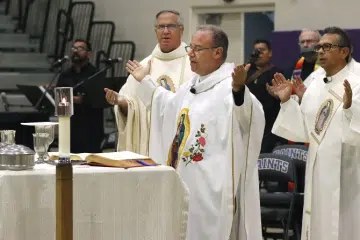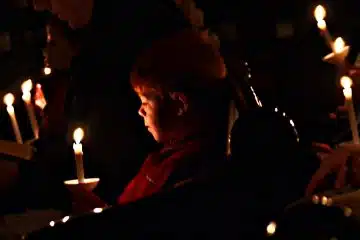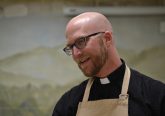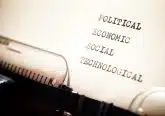Use of technology as vocation tool increasing
Wednesday, June 3, 2009
By Eileen Connelly, OSU
ARCHDIOCESE — Promoting vocations to the priesthood and religious life means meeting young people where they are. These days, that means on the Internet, whether they’re Googling or being active in social networking websites like Facebook.
Having spent most of his years in ministry on college campuses as a professor and chaplain Franciscan Father Don Miller is particularly aware of this. He now serves as vocation director for the Cincinnati-based St. John the Baptist province and said, “I’ve realized if we’re going to reach young men we have to use every means possible.”
The vocation page on the Franciscan friars’ website get more hits than any other, Father Miller said, and he estimated that 90 percent of the contacts he receives from men discerning religious life are via email or the internet. Currently posted on the website are videos of the 15 men in formation with the friars.
“I had them share about whatever they wanted, from their experiences in formation to Franciscan life in general,” Father Miller said, noting that the videos have also been posted on YouTube since Feb. 7 and have received 2,990 hits to date.
 |
| An image of Pope Benedict XVI is seen on a new Vatican Web site as displayed on an Apple iPod touch in Rome May 22. The new Web site www.pope2you.net features iPhone and Facebook applications aimed at reaching youngger generations. (CNS photo) |
Father Miller is also on Facebook, which he said has been useful in corresponding with men who are entering the community and those presently in formation. He has also been blogging for the past three years, covering a variety of topics including updates on vocation related events and province happenings. “I try to provide interesting tidbits,” Father Miller said. “It’s a great way to keep people informed.”
Father Kyle Schnippel, director of the archdiocesan Vocation Office said the use of technology in his ministry is essential. “You have to be present in the world young people populate,” he said. “If you’re not in their world, they’ll never hear or think about the priesthood or religious life. Technology is a good way to break down barriers and present things in a way or language that young people and teens find appealing.”
He noted that even Pope Benedict has entered the world of social networking sites and smartphones with the recent launching of the Pope2You website that allows Facebook users to send virtual postcards with photos of the pontiff and excerpts from his messages. Other applications give seekers audio and video news on Pope Benedict’s travels and worldwide Catholic events. In his weekly audience on May 27, the pope urged young people to use the Internet to build a better world and make the Gospel known.
Father Schnippel said establishing a web presence was a priority when he assumed his current position, including developing a comprehensive question and answer section for men interested in the priesthood. He has also found his personal blog and the official blog of the students at Mount St. Mary’s seminary to be useful tools in promoting vocation awareness and disseminating information.
“We wanted the seminarians’ blog to focus on what life is really like in the seminary, to show that it’s not just about prayer and going to class. There’s a lot more to it,” Father Schnippel said. Among the current entries are photos from the April ordination of the transitional deacons and information about ”Cast Your Nets,” a joint effort of the Vocations Office, Office of Youth and Young Adult Ministry and area youth ministers.
Father Schnippel also takes advantage of various other modes of technology to carry out his ministry, from podcasts to Twitter to Facebook, which he uses to publicize upcoming vocation events. In addition, he does a great deal of texting with young people who are discerning their vocation. Father Schnippel said feedback he has received from men interested in the priesthood indicates they find the archdiocese’s vocation website helpful in the discernment process.
“I know that two of the men hopefully entering (the seminary) this fall follow my blog, as they always comment on things I put there,” he said.
Although the Internet did not play a significant role in the discernment process for Marianist Sister Nicole Trahan, aside from email communication with her congregation, it did contribute to her early formation as a lay Marianist.
“The Marianists offer several online courses on the Marianist charism and history through the University of Dayton and the North American Center for Marianist Studies in Dayton,” she said. “I was fortunate to take an online course on the three founders of the Marianist community that was key in formation.
Sister Nicole, 34, was a member of a lay Marianist community for three years before entering her congregation in September 2005. She started a blog, “The Life of a New Sister,” to keep her family and friends updated about her novitiate experiences. To her surprise, others were also interested. “I never imagined my blog would of interest to people who have never met me. I figured some of my family and friends would visit and perhaps some of our Sisters with whom I did not live,” she said. “I have since realized that there are others who read my blog on a regular basis — other women religious, people who are discerning a call to religious life and others who enjoy reading spiritual reflections.”
In conversations with students at UD, where she works as a campus minister, Sister Nicole has become aware of just how significant technology has become in the discernment journeys of young adults.
“For some young people, the Internet is the first contact they have with religious,” said Sister Nicole who professed her first vows in 2008. “Also, there have been a number of people that I’ve met through my time in formation who found the congregations they entered by doing a Google search. This, too, is a trend that says a lot about how young people are making decisions and learning about religious life. It’s important that all of us take notice of this trend.”
The Sisters of Notre Dame de Namur have taken notice and are responding with the increased use of technology in their vocation ministry, said Sister Angele Lewis, a member of the congregation’s national vocation team. With a database of 1,000 women who have expressed an interest in religious life, members of the team keep in contact with via traditional means, but also follow up using Skype (a software application that enables users to make phone calls over the Internet) and FlashMeeting (an online meeting application that allows a dispersed group of people to meet from anywhere in the world with an Internet connection). The vocation team has also experimented with FlashMeeting for their own monthly meetings and is considering it as a possibility for virtual vocation retreats, a day of reflection or morning of prayer.
Her community currently has five women in formation that made initial contact via the Internet, said Sister Angele, who also maintains a vocation-oriented blog and plans to make use of Facebook in the near future. Other members of the congregation are also becoming aware of the importance of technology in promoting vocations and have been prompted to embrace it themselves with enthusiasm, she added.
“It’s really exciting to see,” Sister Angele said. “Educating the other Sisters helps make our entire operation more successful. Sometimes it can be a little overwhelming to them, but when they see it’s safe and professional, they become more comfortable with it.”
“The new generation of women coming into religious life has much more ease in using technology because they’ve grown up with it,” she added. “What missing with some is their basic faith education and we can help provide that to help strengthen their faith and their call. They may not become Sisters, but they’ll become better Catholics. The challenge is getting the information out there in a way that’s attractive and comfortable for them.”
While the need for using technology in vocation ministry is obvious, Sister Nicole said she is “leery about abandoning tradition means of vocation outreach. I’m not sure how a person discerning religious life could acquire a real understanding of a charism or gain insight into how he or she might fit in with a particular group via the Internet. Personal contact — phone calls, face-to-face meetings and retreats — offer something that technology can not.”
Father Schnippel agrees. “It’s tempting to look at all the technology and think that’s all we have to do (in terms of vocation ministry), but it only serves as contact point, an introduction,” he said. “We have to make the connection and go from there. It’s just a doorway into the young peoples’ world and a way for them to find us more easily. Technology is a tool, but not an end in itself.”













